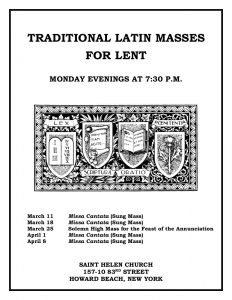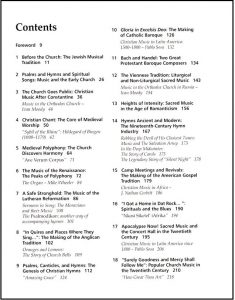For Café readers in New York City: St. Helen Church in Queens (Howard Beach) will present Mass in the usus antiquior on Monday evenings this Lent for the devotion of the faithful. Services will be in the form of a Missa cantata, except for a Solemn High Mass on March 25.

July/August 2019: a chant camp for boys in SoCal
News from St. Michael’s Abbey in Orange County, CA:
Since 1962, St. Michael’s Summer Camp has been providing boys with a unique summer camp experience. Operated by the Norbertine Fathers and fraters (brothers) on their beautiful abbey grounds, the camp combines summer fun with opportunities for growth in the Catholic Faith. Boys from ages 7-12 participate in a number of sports, swimming, hiking, and campfires–as well as Confession, catechism classes, daily Mass, and more! This year, the camp staff is pleased to introduce Sacred Music Week, a week of camp dedicated to learning and singing Gregorian chant and other sacred music. Sacred Music Week (July 28 – August 3) will provide campers with all the usual summer camp activities, in addition to daily choir classes and opportunities to sing for the Holy Mass. No auditions or previous singing experience is required. St. Michael’s Summer Camp is accredited by the American Camp Association. For more information or to register, please visit http://www.stmichaelsabbey.com/summer-camp/
The Herald reviews a history of Christian music
In the Catholic Herald a few days ago, Michael Duggan reviewed a new edition of historian Tim Dowley’s book on the history of Christian music. I haven’t seen it before, but it may be useful.
Here’s an image of the table of contents from the previous edition (click to enlarge): 
More information is at the UK publisher and at Amazon.
Do we need a softer, more secularized approach?
[In the course of a recent on-line conversation about why secular-sounding music doesn’t belong in the Mass, I offered this comment.]
I could understand the intention to create an easy, comfortable experience for outsiders: having the interior of the building look like an auditorium or a shopping mall food court; having no-brainer music that sounds like evangelical choruses from Christian radio. Some clergy and musicians might think that a soft-style approach would help some people feel comfortable setting foot in a Catholic parish church: people whose background didn’t include the faith.
This approach has its limitations, though: it doesn’t provide the liturgical formation that growing Christians need. It reminds me of the idea of having separate Masses for various age groups of young people on Sunday. It’s well-meant, and some people say they like it. But it creates a ghetto situation, and doesn’t lead the children into the regular parish experience.
If there were a Mass conducted specifically for “seekers” as a transitional experience for them — where they wouldn’t be expected to know the rites, sing the songs, stand or sit; where people who aren’t Catholic and aren’t ready to receive Holy Communion could stay in their pews without standing out: there might be some benefit for some souls.
But treating the whole parish as though they aren’t able to appreciate the authentic rites, or genuine church art, or music that sounds like church music: as though these things were over their heads: that’s really a kind of disrespect, and an imposition.
The soft-style approach is ultimately even deceptive, because Christianity is not a low-commitment religion that people can reasonably take or leave, according to their personal tastes and preferences. Belonging to Jesus is a matter of high commitment.
From Abp. Sample’s pastoral letter on sacred music (5)
The Fathers of the Second Vatican Council [wrote]:
The Church acknowledges Gregorian chant as specially suited to the Roman liturgy. Therefore, other things being equal, it should be given pride of place in liturgical services.
The General Instruction of the Roman Missal, in setting out the norms for the celebration of Holy Mass reiterates this last point of the Council:
The main place should be given, all things being equal, to Gregorian chant, as being proper to the Roman liturgy.
One of the great Popes of our time, St. John Paul II, made the teaching of Pope St. Pius X his own:
With regard to compositions of liturgical music, I make my own the “general rule” that St Pius X formulated in these words: ‘The more closely a composition for the Church approaches in its movement, inspiration and savor the Gregorian melodic form, the more sacred and liturgical it becomes; and the more out of harmony it is with that supreme model, the less worthy it is of the temple.’ It is not, of course, a question of imitating Gregorian chant but rather of ensuring that new compositions are imbued with the same spirit that inspired and little by little came to shape it.
[…] The U.S. Bishops’ document on sacred music, Sing to the Lord, also reminded the Church in the United States of the importance and pride of place enjoyed by Gregorian chant. Some practical suggestions are given in that document for the implementation of this principle.
Given all of this strong teaching from the Popes, the Second Vatican Council, and the U.S. Bishops, how is it that this ideal concerning Gregorian chant has not been realized in the Church? Far from enjoying a pride of place in the Church’s Sacred Liturgy, one rarely if ever hears Gregorian chant.
This is a situation which must be rectified. It will require great effort and serious catechesis for the clergy and faithful, but Gregorian chant must be introduced more widely as a normal part of the Mass.
From Abp. Sample’s pastoral letter on sacred music (4)
Since everything associated with the Mass must be beautiful, reflecting the infinite beauty and goodness of the God we worship, this applies in a special way to the music which forms an essential and integral part of our divine worship. In the words of Pope Francis:
Liturgical and sacred music can be a powerful instrument of evangelization, because it gives people a glimpse of the beauty of heaven.
Pope Benedict XVI states:
Certainly, the beauty of our celebrations can never be sufficiently cultivated, fostered and refined, for nothing can be too beautiful for God, Who is Himself infinite Beauty. Yet our earthly liturgies will never be more than a pale reflection of the liturgy celebrated in the Jerusalem on high, the goal of our pilgrimage on earth. May our own celebrations nonetheless resemble that liturgy as closely as possible and grant us a
foretaste of it!
Pope St. Pius X spoke of the artistic value of sacred music, another way of considering its intrinsic beauty:
[Sacred music] must be true art, for otherwise it will be impossible for it to exercise on the minds of those who listen to it that efficacy which the Church aims at obtaining in admitting into her liturgy the art of musical sounds.
(From “Sing to the Lord a New Song” by Abp. Alexander Sample, 2019; emphasis added)
From Abp. Sample’s pastoral letter on sacred music (3)
With this understanding of the essential nature of sacred music, what might be said of its purpose? Sacred music, being a complementary part of the solemn liturgy, participates in the general scope of the liturgy, which is the glory of God and the sanctification and edification of the faithful.
The following statement from the Second Vatican Council in 1963 is drawn from the motu proprio Tra Le Sollecitudini of Pope St. Pius X of 1903 […]:
Accordingly, the Sacred Council, keeping to the norms and precepts of ecclesiastical tradition and discipline, and having regard to the purpose of sacred music, which is the glory of God and the sanctification of the faithful, decrees as follows…
The Church solemnly teaches us, then, that the very purpose of sacred music is twofold: the glory of God and the sanctification of the faithful. This understanding of the essential nature and purpose of sacred music must direct and inform everything else that is said about it. […]
With a proper understanding of the nature and purpose of sacred music and its relationship to the Holy Mass, it is necessary to next discuss the essential qualities of sacred music. These qualities are not arbitrary or subjective. Rather they objectively flow from the essential nature and purpose of sacred music itself.
Church teaching emphasizes that the music proper to the Sacred Liturgy possesses three qualities: sanctity, beauty and universality. Only music which possesses all three of these qualities is worthy of Holy Mass.
